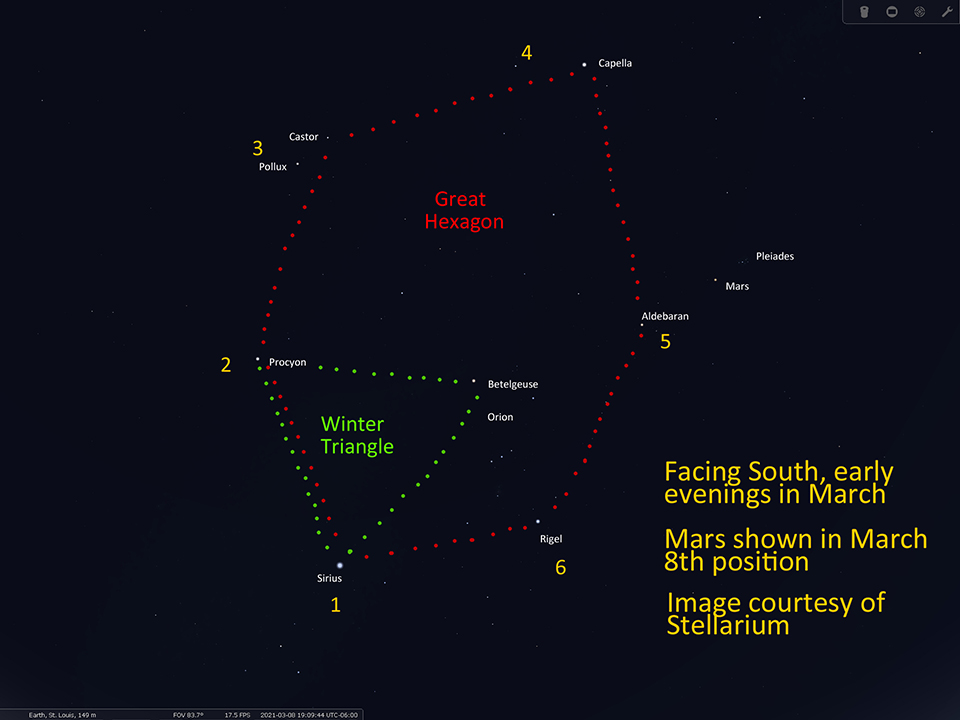March is a time of transition. As the Earth’s northern hemisphere tilts more towards the Sun, our star rises earlier in the morning, sets later at night, and rises higher in the sky in the middle of the day. Day and night become equal close to the date of the equinox on March 20th, marking the official start of spring. The temperature steadily rises. Sometimes, though, the transitions are not smooth. Just eight years ago, on March 24, 2013, St. Louis received 12.4 inches of snow, and unbelievably, four inches of snow fell on May 2, 1929!
Some similar transitions occur in the sky at this time of year. There are 88 constellations in the sky and many of them are made up of dim stars that can’t be easily seen from urban skies. It is often easier to learn the sky by identifying larger groups of bright stars. Two of these are usually associated with winter, but carry over into much of the spring. These are the Great Hexagon (some call it the Winter Hexagon) and the Winter Triangle.
The starting point for both groupings is the star Sirius, shining brilliantly in the south in the early evening. If you ever see a brighter starlike object that is not moving like a airplane or satellite, it must be a planet, usually Venus or Jupiter or rarely like last fall, Mars. Sirius is known as the Dog Star, as it is the brightest star in the constellation Canis Major, the Greater Dog. The next bright star above and somewhat left of Sirius is the lesser Dog Star, Procyon. Continuing upward, now very high in the south, are two bright stars, side by side, none other than the famous Gemini twins, Pollux and Castor. To the west, also very high, is Capella. During March, if you look below Capella, there will be two almost equally bright stars shining close together, high in the southwest to west. Look closely, and you will note that both have a slightly reddish or orange tint to them. The one that is twinkling more is the eye of Taurus, the Bull, the star Aldebaran. The other shines more steadily because it is much closer to Earth- the planet Mars, which just happens to be in the same direction at this point in its orbit.
Finally, go back to Sirius and note the bright star to the right and slightly higher. It is Rigel, brightest star in Orion, the Hunter. The bright stars of Orion form a distinctive somewhat rectangular shape, with the three stars of the famous belt in the middle. I discussed Orion and the two Dog Stars in depth in the January 2020 and February 2020 editions of this blog. A line through Orion’s belt can help you confirm your identification of Sirius, to the lower left, and Aldebaran, to the upper right. Connect Sirius, the two Dog Stars, the Gemini twins, Capella, Aldebaran, Rigel, and then back to Sirius, and you have completed the Great Hexagon!
The Hexagon is great not only in the number of bright stars but also huge in size, extending from fairly low in the south at this time of year to nearly overhead and then to Aldebaran in the west. Inside the Great Hexagon is one more bright star, Betelgeuse. In case it feels left out, stargazers have also noticed that Betelgeuse, Procyon, and Sirius make up an almost perfectly equilateral Winter Triangle. There are a lot of differences among the stars in the Hexagon. Sirius and Procyon are among the nearest stars to the Sun, at distances of 8.6 and 11 light years, respectively. On the other hand, the light of Betelgeuse takes about 640 years and Rigel 860 years to get to your eyes, making them among the more distant stars visible to the naked eye. Nevertheless, due to their huge size and luminance, they easily qualify as “first magnitude” stars. Notice also some differences in color among the stars of the Great Hexagon and Winter Triangle. Due to their different temperatures, Rigel and Sirius seem white hot, maybe tinged with blue as I see it, while Aldebaran and Betelgeuse look decidedly reddish orange.
The star map that I have created using the Stellarium program is correct for the early evening during March. As the hours pass, Earth’s rotation causes the stars of the Great Hexagon drop towards the southwestern and western horizon. During March, you have to stay up past midnight to see this. However, Earth actually takes four minutes less than 24 hours to rotate once on its axis. This might not seem like much, but it eventually adds up, so that the sky at any given time appears the same two hours earlier a month later. By May, the lower stars in the Great Hexagon will be gone at dusk, leaving the upper stars on my map to form another very interesting pattern, overshadowed now but prominent then. Stay tuned for the reveal of that mystery in May. We will just have to persevere until then…

Our Gateway to the Stars program is currently scheduled to resume on May 8, with “The Globe at Night.” Featuring educational programming on light pollution, astronomy, and the national parks as well as virtual stargazing, Gateway to the Stars will be held monthly from May-October. The National Park Service is grateful for the invaluable assistance of the St. Louis Astronomical Society, Dark Sky Missouri, and other organizations.
